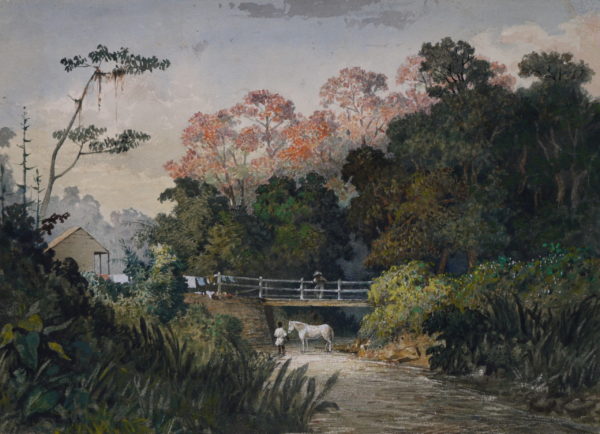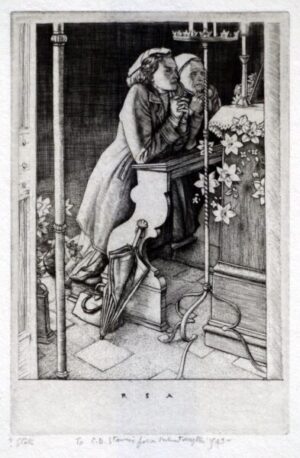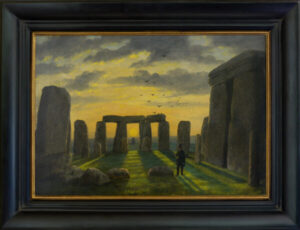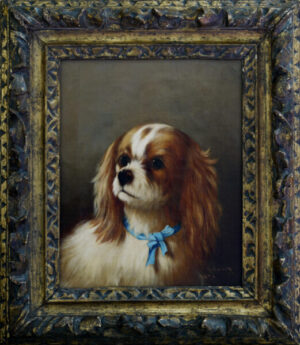Description
This painting is thought to be looking south toward the bridge over the Maraval River on Champs Elysées Estate at the entrance to the Maraval Valley, near Port of Spain. The estate was owned by the de Boissiere family.
The red immortelle trees were planted to protect the cocoa trees on the estate and can still be seen today on the hills to the left, more than 150 years after this watercolour was painted.
This watercolour reflects the intensity of the colours of the tropics, familiar in so many of the paintings of Michel-Jean Cazabon.
The year 2013 marked the two hundredth anniversary of the birth of Michel Jean Cazabon, Trinidad’s great nineteenth Century artist, who was born on the 20th September 1813 on Corinth Estate near San Fernando, Trinidad’s second port.
The Cazabon name originates in Basque country, which spans north-eastern Spain and south-western France. Bordeau in France, the nearest large port to the region, was the point of departure for many of the French immigrants to the West Indies and North America. It is thought that the first Cazabons in the West Indies went to the French island of Martinique; records indicate that the family had settled there as early as the 1730s.
The artist’s mother, Rose Debonne, married Francois Cazabon in Trinidad about 1797, bringing into the marriage the 270-acre Corinth Estate in North Naparima. Their families were part of the free coloured/free black community from St. Pierre in Martinique, who settled in the Naparimas under the Spanish Government’s Cedula of Population. The Decree was designed to encourage immigration into an undeveloped Trinidad at the end of the eighteenth Century.
The new immigrants soon established a thriving sugar industry. San Fernando, the port from which their produce was shipped, developed rapidly under the leadership of Jean Baptiste Jaillet, an astute coloured planter who gained wealth and power through his land dealings. He used his influence to encourage other coloured immigrants to settle in the surrounding areas of the Naparimas. The community’s respect for Jaillet is demonstrated by San Fernando Hill being, at the time, known colloquially as Morne Jaillet. From the community there emerged an ambitious and articulate group, from which came many of the leading professional and intellectual personalities of nineteenth Century Trinidad.
Trinidad became British in 1797 when the Spanish Governor, Don Jose Maria Chacon, surrendered to the British naval force under Sir Ralph Abercromby. Under the new British administration, the Naparimas remained socially independent and were treated with a great deal of suspicion and prejudice by the British Governors, in particular Governor Sir Ralph Woodford. After a meeting between Lord Bathhurst and Jean Baptiste Philippe in 1829, when he presented his Treatise, A Free Mulatto, the coloured community achieved equal rights.
When he was thirteen, Cazabon was sent to England to attend St. Edmund’s College in Ware. It is interesting that despite their French background, his parents preferred to send him to an English school, perhaps to prepare him for life in an English colony. Later he went to Paris to study art and where he was a student of the marine painter, Jean-Antoine Theodore Gudin (1802-1880), the portraitist Michel-Martin Drolling (1789-1851), Antoine Leon Morel-Fatio (1810-1871) and, it is believed, Paul Delaroche (1797-1856). It is likely that Cazabon learnt his printing techniques from Morel-Fatio. Cazabon exhibited at the Salon du Louvre in 1839 and every year from 1843 to 1847. He travelled extensively in France and painted in Italy. His school was that of the French Landscape, his work showing a close affinity to that of another pupil of Delaroche, Charles-Francois Daubigny (1817-1878).
Cazabon returned to Trinidad in 1848 and in 1851 produced a series of eighteen lithographs, Views of Trinidad. In 1857 he published a second series, Album of Trinidad, and in 1860 contributed to two other series, Views of Demerara and Album Martiniquaise. Cazabon’s œuvre is extensive; his work shows a wide knowledge of media – oils, watercolours, gouache, gesso, etc. Although he was primarily a watercolourist and landscape artist, both his formal and informal portraits are highly valued, and his illustrations for the newspapers of the day, of important historic significance. His sketches for the Illustrated London News give us an insight into life in Trinidad, showing the riots of 1845, the trial of the rioters, the great fire of Port of Spain of 1850 and, on a more social side, “Ball on board Her Majesty’s Ship Wellesley” in Port of Spain.
In 1860, Cazabon moved to Martinique, where he lived and worked in Saint Pierre, but his success was limited and he returned to Trinidad about 1870. He taught art privately and at both Queen’s Royal College and St. Mary’s College and continued to paint from his studio on Edward Street, Port of Spain, for a diminishing clientele. He died in virtual poverty on 20th November 1888. He was buried in the Lapeyrouse Cemetery. In 2010 his grave was restored by the conservation group, Citizens for Conservation.
In Trinidad, Cazabon’s most important patron was Lord Harris, the English Governor from 1848 to 1854. The Harris Collection of 44 paintings, now displayed at the family home at Belmont in Kent, England, is perhaps the most important collection of nineteenth Century visual references of Trinidad. Several other less extensive, but important collections were commissioned by William Burnley, the Scottish-American planter, John Lamont and the Earl of Dundonald among them.
Script by Geoffrey MacLean



